The Invisible Black Victim: How American Federalism Perpetuates ...
The Invisible Black Victim: How American Federalism Perpetuates ...
The Invisible Black Victim: How American Federalism Perpetuates ...
You also want an ePaper? Increase the reach of your titles
YUMPU automatically turns print PDFs into web optimized ePapers that Google loves.
symbolic. <strong>The</strong> pathologies of the inner city cannot be remedied by creating stronger [gun]<br />
laws (Hearing before the Subcommittee on Juvenile Justice of the Committee on the<br />
Judiciary. Senate, 1994, S521-6, p. 69).<br />
This is particularly interesting, given that the NRA made virtually the opposite argumentFthat<br />
uniformity is a necessityFwhen opposing Philadelphia's and Pittsburgh's efforts to impose<br />
stricter gun control legislation precisely because of the unique contexts for racial minorities<br />
that occur in those cities (see Miller 2008). While this is an excellent illustration of the NRA's<br />
mastery of <strong>American</strong> federalism, it also reveals the real limitations on congressional power. It<br />
is with no small irony that one reads the NRA representative's comments, knowing that the<br />
remedies for ''pathologies of the inner city'' are on the margins of the lawmaking powers of<br />
the central government.<br />
What keeps groups representing minority crime victims from greater visibility in<br />
congressional crime debates? Table 4 compares criminal justice witnesses to citizen<br />
witnesses by decades and illustrates the fact that more witnesses representing citizen groups<br />
with broad concerns appeared during the 1970s, when riots, gun violence, prison, and police<br />
issues were on the congressional agenda more than at any other time period.<br />
This finding is particularly important because much of the extant scholarship about racial<br />
inequality, crime, and punishment centers around national processes that led lawmakers to<br />
disavow racial progress and promote crime control as a mechanism for maintaining racial<br />
hierarchy during the 1960s and 1970s (Beckett 1997). Many also see this era as an important<br />
break with a more rehabilitative past that emphasized reintegration, in contrast with a more<br />
managerial model of crime control that exists today (Garland 2001; Simon 2006). <strong>How</strong>ever,<br />
broad citizen groups most likely to call attention to racial inequities and frame crime<br />
problems in terms of rehabilitative potentialsFincluding the NAACP, the Urban League, the<br />
National Urban Coalition, Operation PUSH, El Pueblo Unido, and the National Center for<br />
Urban and Ethnic AffairsFall appeared more frequently in the 1970s than in any other decade<br />
under examination here. This suggests that while the issues of the day (urban riots, prison and<br />
police upheavals, gun violence, and civil rights protests) may have provided opportunities for<br />
lawmakers to exploit law and order fears as a proxy for animosity toward blacks, and/or to<br />
back off from prior commitments to rehabilitative ideals, they also provided an opportunity<br />
for crime issues to be connected to broader social problems of racial inequality. In other<br />
words, the same forces that drove crime onto the political agenda as an opportunity for<br />
retrenchment and racial backlash also opened up possibilities for framing crime as part of a<br />
larger civil rights program. As this political moment passed, however, the process reverted to<br />
its default state and the normal routines of congressional attention to crime returned,<br />
decoupling the issue from other problems and responding to the latest crime issue.<br />
<strong>The</strong> absence of neighborhood, community, grassroots citizen organizations representing the<br />
urban core in general, but particularly after the 1970s, is glaring. One explanation is that these<br />
groups are effectively represented by the larger, national organizations such as the NAACP<br />
and the Congress on Racial Equality. Another is that they are choosing to opt out of that<br />
political venue. <strong>The</strong>re are several reasons to be skeptical of both of these explanations. First,<br />
as we have seen, these national groups appeared at a tiny fraction of hearings analyzed, so the<br />
voice of urban minorities, even if it were represented in those groups, would still be<br />
extremely small. <strong>The</strong> limited presence of these national groups is somewhat of a puzzle. <strong>The</strong>y<br />
are clearly not resource-poor, and they have demonstrated their willingness and capacity to<br />
fight political battles in a wide range of legislative and legal venues. Some have suggested














